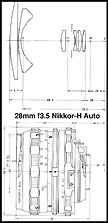Non-Ai 28mm f/2.0 Nikkor-N Auto
wideangle lens
Introduced
back in April, 1971, the non-Ai Nikkor wideangle lens was once the fastest of wideangle
lenses with an angle of view wider than 74° until Canon and Olympus brought an
competing super fast wideangle lens each at the focal length of 24mm with their ultra-fast
Canon FDn 24mm f/1.4L
and OM
Zuiko 21mm f/2.0
a decade later in 1981. This fast speed Nikkor wideangle lens has built a fine reputation
over the years that be able to provide exceptionally high resolution and image contrast
even at its full apertures. This speed permits easy, accurate focusing and facilitates
picture taking indoors or under any unfavorable lighting condition and making it
a firm favourite among serious amateurs and professional users.
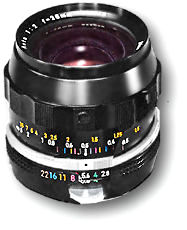 |
One interesting aspect of this very appealing Nikkor wideangle lens was its rear group of lens elements where it shifts its relative position to other elements according to focused distance. This system, termed it as automatic "floating elements" correction or more popular known as CRC (Close range correction system). This optical system employed has enabled wideangle lenses with large aperture to maintain their excellent image quality be consistently maintained over entire focusing range even when used at its respective closest focusing range. This innovative optical design was first introduced in a series of three Auto Nikkor wideangle lenses (The other two lenses were Nikkor 24mm f/2.8 & Nikkor 35mm f/1.4) and this has proved to be a trend setting to overcome aberration and maintain excellent optical performances at close focusing distances of Nikkor wideangles. |
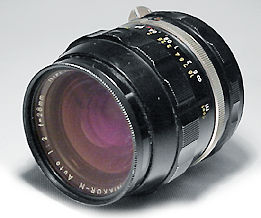 |
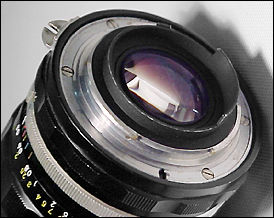 |
NOTE:- Refer to the Rangefinder Nikkor lenses section for more info |
Just like equally brilliant Nikkor 35mm f/1.4 wideangle lens, this 28mm Nikkor wideangle lens was among the first few original batches of lenses that have been specially treated with Nikon proprietary (NIC) lens coating process - NIC is a multi-layer lens coating process that ensures each glass-to-air surface of the optical elements within the lens was coated according to their respective reflective index to provide an optimum photographic results. The Nikkor 28mm f/2 wideangle was especially designed to use in adversely low available light photography and may find many practical usage. It was highly recommended for the news or magazine photographer as well as for industrial, architectural or commercial photographers.
Even among all the available Nikkor 28mm f/2.0 wideangle lenses introduced thus far, there could be presence of a few variations with differing specifications, appearance and performance. The early Ai version introduced subsequently was obviously a direct upgrade from this older Non-Ai Nikkor wide. However, such lens updating process also saw its weighs been increased slightly from 345g to 355g. However, despite all its cosmetic changes, there was an Ai version that followed which Nikon has successfully improved its minimum focusing distance. The subsequent migration to Ai-S lens coupling system also ended it to have a revised design in 1981, the updated design enables it focuses even closer.
 |
 |
 |
 |
 |
|
 |
Specifications: |
|
|
Credit: Image(s) courtesy of Jun Wang ®™ where I found the image(s) from his excellent Ebay Store. All image(s) appeared herein are Copyright © 2006. All rights reserved. Please respect the visual property of the contributing photographer.
Picture
angle: 74° at infinity
Distance scale: Graduated both in meters and feet up to 0.3m and 1 ft
Aperture scale: f/2.0 - f/22
Aperture diaphragm: Fully automatic
Meter coupling prong: Integrated (fully open exposure metering)
Attachment size: 52mm (P=0.75)
Filter: 52mm screw-in
Hood: HN-2
Dimensions: 64.5mm dia. X 70mm length (2-17/32 in. X 2-3/4 in.)
Weight: 345g (12.2 oz)
Accessories: 52mm Snap-On front cap (108 - 00 - 400), rear cap type F (108
- 00 - 401), 52mm screw-in lens hood (108 - 01 - 201), leather case CL4 (108 - 00
- 303), plastic case type S (108 - 00 - 300), flexible pouch No. 51 (108 - 00 - 302); Product Code No.
for this older version of 28mm lens: 108-01-108
NOTE: Serial number for this old non-Ai version of this Nikkor 28mm f/2.0 may have been began with 288801
Non-Ai
28mm
f/3.5
Nikkor-H Auto
This
elegantly designed Nikkor wideangle lens was introduced immediately after the debut
of the Nikon F in 1959. This wideangle lens has long been a hot favorite among many
Nikon-armed photographers who were busy covering news events during those days. Many
of these old non-Ai-Spec Nikkor wideangle lenses had accompanied many photojournalists
covering in Vietnam War and good users reports have helped to gain its popularity.
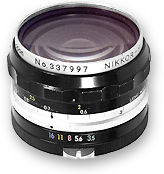 |
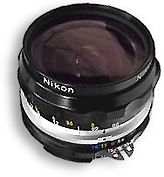 |
The testimonials of ruggedness of Nikon SLRs and fine optical quality of the Nikkors were further endorsed by these favorable real war zone reporting via images published by media. Many soon have realized these cameras and lenses can be extremely reliable and quality of the Nikkor lenses was well recognized. Naturally, many amateurs soon followed and it was one of the best selling Nikkor wideangle during those budding years of 35mm reflex photography. |
The early version of this Nikkor wideangle may bear lens data engraved with focal length information that termed as "cm" rather than commonly used "mm" (millimeter) at later years. It may also carried with a alphabet that signifies the number of elements used inside the optical construction. The "H" for the 28mm f/3.5 here means six optical lens elements were being used in its design. Early lens data has Nippon Kogaku instead of Nikon, those with the latter name tag were probably appeared after late '60.
 |
These designation and classification of lens type has been dropped by Nikon after the first quarter of the seventies. Other than the physical appearance that might varies (scalloped focusing and aperture ring design). Another not-so-secure way in visual identification that may help differentiating various versions was, since most of these older non-Ai lenses have only a minimum aperture of f/16 instead of f/22. Lenses that have that f/22 minimum aperture usually were introduced after year 1975. |
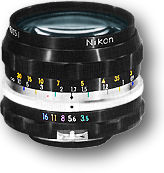 |
Similar to many other Nikkor wideangle lenses (With the exception of ultrawide 2.1cm f/4.0 Nikkor-O), the 28mm f/3.5 Nikkor-H was using a retrofocus design optically. It consists of an optical formulation where it adopted a 6 elements in 6 groups in its optical construction. This popular wideangle lens was specially designed to correct spherical aberrations, eliminating the displacement of focus, which was quite possible to occur as the diaphragm is stopped down. The early 28mm has no rubberized grip on the focusing ring and some have silver focusing lens barrel. |
Although this version of the lens has not been treated with Nikon NIC lens coating process yet, the lens was still able to provide vivid contrast and brilliance even at its full lens aperture opening, with minimum level of coma and distortion exhibits. These outstanding features make this wideangle equally favorable for panoramic landscapes, candid work and for architectural and interior photography.
Meter coupling prong: Integrated (fully open exposure metering)
Attachment size: 52mm (P=0.75); Filter: 52mm screw-in
Dimensions: 62.5mm dia. X 54mm length (2-7/16 in. X 2-1/8 in.)
Weight: 215g (7.6oz) Accessories: 52mm Snap-On front cap (108 - 00 - 400), rear cap type F ( 108 - 00 - 401), 52mm screw-in lens hood (108 - 01 - 202), leather case (108 - 00 - 305), plastic case type S (108 - 00 - 300), flexible pouch No. 51 (108 - 00 - 302) Product Code No. for this lens: 108-01-102
Note: Serial number for the earliest version may have been started with 301011. Lenses that has "C" may bear numbers from 850001- 898367* produced after 1967. * Reference: Peter Braczko.
The next upgrade saw the Nikkor wideangle lens that appeared to have some cosmetic differences and it was slightly heavier than previous version. However, there was another subsequent version which has a great similarities with the Ai version that followed in late 1977. That variation of the non-Ai wideangle lens was believed to have been introduced between 1975 to 1977, see NEXT section for more info.
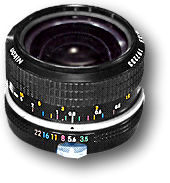 |
Specifications |
Aperture diaphragm: Fully automatic
Meter coupling prong: Integrated (fully open exposure metering)
Attachment size: 52mm (P=0.75)
Hood: HN-2
Filter: 52mm screw-in
Dimensions: 63.5mm dia. X 54mm length (2-1/2 in. X 2-1/8 in.)
Weight: 230g (8.1 oz)
Accessories:52mm Snap-On front cap (108 - 00 - 400), rear cap type F (108 - 00 - 401), 52mm screw-in lens hood (108 - 01 - 201), lens cases: CL-31, No 54, CP-1
28mm focal length
Manual Focus Nikkor Lenses:
|
Early
non-AI versions
| mid-1970
(pre-AI)
| Late
1970
| Early
1980 - Present:
28mm
f/2.0
; 28mm
f/2.8
| 28mm
f/3.5 | Relative: PC-Nikkor
28mm f/2.8
and PC-Nikkor
28mm f/4.0
| Back | to Main Index Page of MF Nikkor lenses at 28mm focal length
| Message Board |
for your
Nikkor
Optics
in a shared environment
| Message Board | Specifically for Dispose or Looking for new/used Nikon/Nikkor photographic equipment
| Nippon Kogaku Rangefinder Resources | Nikon F | Nikon F2 | Nikon F3 | Nikon F4 | Nikon F5 | Nikon F6 | Nikkormat / Nikomat | Nikon FM Series | Nikon FE/ FA | Nikon EM/FG/FG20 | Nikon Digital SLRs | Nikon - Other models |
Nikon MF RF-Nikkor lenses for Rangefinder
cameras:-
Main Index Page
Nikon
Auto Focus Nikkor lenses:- Main
Index Page
Nikon
Manual
Focus
Nikkor lenses:-
Fisheye-Nikkor Lenses - Circular |
Full Frame |
Ultrawides Lenses - 13mm15mm18mm20mm |
Wideangle Lenses - 24mm28mm35mm |
Standard Lenses - 45mm 50mm 58mm | Telephoto Lenses
- 85mm105mm135mm180mm & 200mm |
Super-Telephoto Lenses - 300mm 400mm 500mm 600mm 800mm 1200mm |
 |
Special Application
lenses: Micro-Nikkor Lenses - 50mm~55mm -60mm 85mm -105mm 200mm Micro-Zoom 70-180mm Perspective Control (PC) - 28mm 35mm PC-Micro 85mm Dedicated Lenses for Nikon F3AF: AF 80mm f/2.8 | AF 200mm f/3.5 EDIF Depth of Field Control (DC): 105mm 135mm Medical Nikkor: 120mm 200mm Reflex-Nikkor Lenses - 500mm 1000mm 2000mm Others: Noct Nikkor | OP-Nikkor | UV Nikkor 55mm 105mm | Focusing Units | Bellows-Nikkor 105mm 135mm Nikon Series E Lenses: 28mm35mm50mm100mm135mm | E-Series Zoom lenses: 36~72mm75~150mm70~210mm |
MF Zoom-Nikkor Lenses: 25~50mm | 28~45mm | 28~50mm | 28~85mm | 35~70mm | 36~72mm E | 35~85mm | 35~105mm | 35~135mm | 35~200mm | 43~86mm | 50~135mm | 50~300mm | 70~210mm E | 75~150mm E | 80~200mm | 85~250mm | 100~300mm | 180~600mm | 200~400mm | 200~600mm | 360~1200mm | 1200~1700mm
Tele-Converters: TC-1 | TC-2 | TC-200 | TC-201 | TC-300 | TC-301 | TC-14 | TC-14A | TC-14B | TC-14C | TC-14E | TC-16 | TC-16A | TC-20E
Recommended links to understand more technical details
related to the Nikkor F-mount and production Serial Number:
http://rick_oleson.tripod.com/index-153.html by: my
friend, Rick Oleson
http://www.zi.ku.dk/personal/lhhansen/photo/fmount.htm by: Hansen,
Lars Holst
http://www.mir.com.my/rb/photography/hardwares/nikonfmount/lens2.htm
http://www.photosynthesis.co.nz/nikon/serialno.html
Recommended Reading Reference on Nikon cameras and Nikkor lenses | about this photographic web site
| | Back | Main Index Page of Nikkor Resources | Back | Main Index Page of Pictorial History of Nikon SLRs |
| Home - Photography in Malaysia |
![]() Co-developed
with my web buddy, Rick Oleson® &
Co-developed
with my web buddy, Rick Oleson® & ![]() Denmark, Creator of the Nikon
Repair Group Mailing-List;
A
contributing effort to Michael Liu's Classic Nikon SLRs and
Nikkor optic site.
Denmark, Creator of the Nikon
Repair Group Mailing-List;
A
contributing effort to Michael Liu's Classic Nikon SLRs and
Nikkor optic site.
Credit: MCLau®, who has helped to rewrite
some of the content appeared this site. Chuck Hester® who has been helping
me all along with the development of all these Nikon websites; Lars Holst Hansen, 'Hawkeye'
who shares the same passion I have; Ms Rissa, Sales manager
from Nikon Corporation Malaysia for granting permission to use some of the official
content; Ted Wengelaar, Holland
who
has helped to provide many useful input relating to older Nikkor lenses; Some of the references
on production serial numbers used in this site were extracted from Roland Vink's website; Hiura Shinsaku from Nikomat
Club Japan. Lastly,
to all the good people who has contributed their own expeience, resources or kind
enough granted permission to use their images of their respective optic in this site.
It is also a site to remember a long
lost friend
on the Net. Note:certain content and
images appeared in this site were either scanned from official marketing leaflets
& brochures published by Nikon and/or contribution from surfers who claimed originality
of their work for educational purposes. The creator of the site will not be responsible
for may discrepancies arise from such dispute except rectifying them after verification. "Nikon", "Nikkormat", "Nippon Kokagu
KK"
& "Nikkor" are registered
tradename of Nikon Corporation Inc., Japan. Site made with an Apple IMac.
